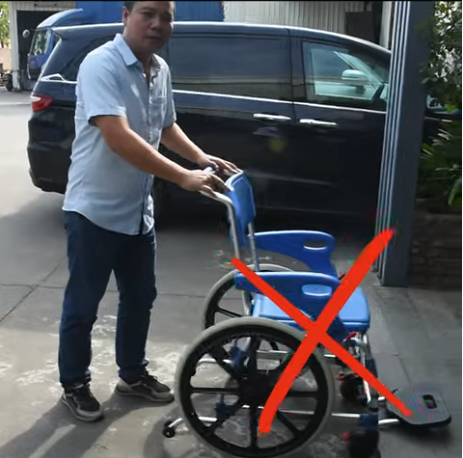Why Most People Struggle to Move a Rolling Commode Chair Upstairs
If you've tried pushing a KDB Medical wheeled commode chair up stairs by lifting the front wheels first, you know how unstable and tiring it can be. The chair can tilt or slip—especially risky when someone is seated.
The Common Mistake
Most caregivers tilt the chair forward, lifting the small front wheels first. This shifts weight dangerously and reduces control.
The Safe and Proper Way: Rear-Wheel-First Method
Use this simple method recommended by safety professionals:
Step 1: Get Ready
✅ Lock the brakes before you approach the stairs
✅ Remove the bucket or any detachable parts to lighten the load
✅ Make sure the stairs are dry and clear of debris
Step 2: Use the Rear Wheels First
Stand behind the chair and tilt it back about 30°
Let the larger rear wheels touch the edge of the stair
Pull the chair slowly up, using your legs to lift—not your back
Step 3: Move the Front Wheels Up
Once the rear wheels are secure on the step, gently push forward
Lift the front wheels straight up (not at an angle) onto the step
Watch our video demo for a visual walkthrough (https://youtube.com/shorts/StBeR4SANK0?si=JSIfmRW5t6dFgreg)
Why This Works
Better Balance: Rear wheels handle most of the weight
Safer Angle: Keeps the chair’s center of gravity low
Smart Design: KDB’s puncture-proof wheels grip stair edges firmly
Avoid These Mistakes
| ❌ Don't Do This | ✅ Do This Instead |
| Lift front wheels first | Start with rear wheels |
| Quick, jerky motions | Use slow, steady lifting |
| Skip brake checks | Test brakes on every landing |
Need More Help?
📞 Call our support team for expert advice
Browse our stair-safe commode chairs
FAQ
Q: Can this chair go up stairs by itself?
A: No. This chair must be moved by a caregiver. It's not designed for self-propelled stair use.
Q: How to keep the wheels from slipping?
A: Wipe wheels weekly and check tread wear. Replace worn wheels with original KDB parts.
